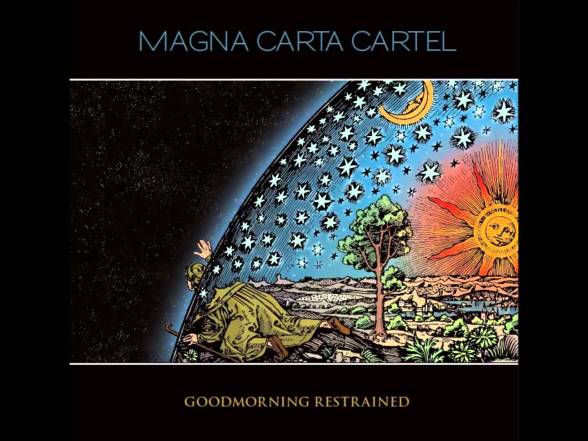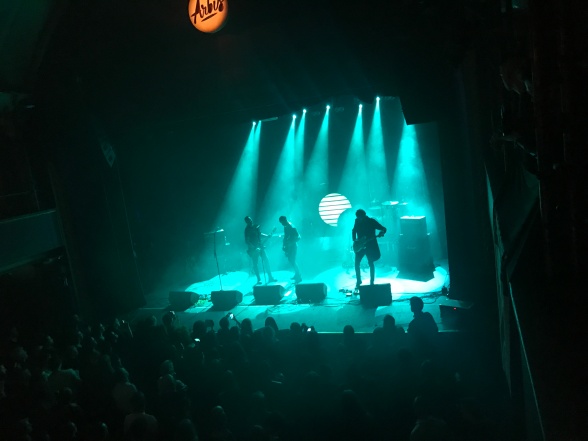Rock is Dead? Long live the Hip-Hop King? Not so fast—while it is true that Hip-Hop/R&B have surpassed Rock in sales in the US, sales are probably not the best measure for the health of an art form. Sales figures measure popularity and revenue, which occasionally, but not often, coincide with innovative artistry. Perhaps it is an indication that Hip-Hop/R&B have reached the same stage of development that Rock hit by the mid-80s. At that point, Rock had enjoyed two decades of cultural dominance, but by that stage, it was difficult to take it seriously as a countercultural force, which is now the case with Hip-Hop and Rap. While this may sound like an attack on Hip-Hop and Rock, it’s not. This pattern repeats itself in every style of music—the style is born, it matures and ripens, then it falls off after exhausting the musical materials that define it as a style, entering into a final era of cliche and repetition which can go on, it seems for some styles, indefinitely. It’s a natural life cycle for all art, and like all natural cycles, the end of one era usually heralds the beginning of something new, which is precisely what I believe is happening in the world of rock—a renaissance of sorts, made possible by technological developments that have freed new generations of musicians to make their own music entirely as they see fit, without concerns about writing a hit. Modern rock groups are now able to enjoy the artistic freedom that has long been enjoyed by jazz and classical musicians, and the result is a flowering of creativity unencumbered by industry mandates that have been rendered largely meaningless in the digital age. In this series of articles, I will look at several groups that I think are reinvigorating the rock genre with noteworthy artistic success and promise for future development of a genre whose death, I’m sure, has been greatly exaggerated. The first group is…

Magna Carta Cartel (MCC): PART I
Some of my favorite contemporary music comes from Northern Europe, a region which has given the world some of the best and well-crafted pop, rock/metal, and EDM music (ABBA, Katatonia, Opeth, The Knife, Röyksopp, Trentemoller), as well as some of the most innovative jazz (Bobo Stenson, Jan Garbarek, Tomasz Stanko) and classical music (Arvo Pärt, Esa-Pekka Salonen, Henryk Gorecki) of the last 50 years. The latest addition to this esteemed list of artists is a group from Linköping, Sweden, who call themselves “Magna Carta Cartel” (MCC).
The group formed in 2006, from the ashes of several other groups, most notably a very catchy pop-punk group named Subvision. Unfortunately, like Subvision, MCC only released one full length recording (“Goodmorning Restrained”) and the band was put on hiatus in 2009. A new band was formed, (GHOST BC) a provocative, theatrical, and monothematic band—the theme being overt, unabashed Satanism. Unlike MCC, Ghost BC was also anonymous, which added to the mystery and the appeal. (I wrote a few articles about them, doing a bit of forensic musicology to unmask the members.) I first saw Ghost BC in Detroit in 2013, and that is when I knew that at least some of the members were definitely from Magna Carta Cartel—I heard one of the guitar players, a masked Nameless Ghoul who I now know was Martin Persner, play a few short licks from “Goodmorning Restrained.”
At that point, I had not listened carefully to MCC and as such, I didn’t really understand the group’s aesthetic. It wasn’t until I listened to the album several times from beginning to end that I realized that, while Ghost BC had the spooky looks and the outstanding hooks to fuel a successful international metal career, the real musical genius was to be found in the group’s short-lived predecessor, MCC.
I was therefore thrilled to hear that MCC had reformed with former Ghost BC guitarist Martin Persner (vocals and guitar), his brother Arvid Persner (drums), and Pär Glendor (bass), all original members of MCC. In 2017, they released a new recording, the first in over a decade, entitled “The Demon King” and played live shows this year in London and in Nörrkoping, Sweden, with plans to tour in Europe, and hopefully North America as well.
The group describes itself as follows:
We are MCC [Magna Carta Cartel] from Sweden. We play magical rock music.
MCC writes and performs radio-edited movie themes, for daily life and death. Our music reminds of Vangelis meeting Tom Petty, trying to reach U2, willing to be Joy Division, feeling like ABBA, longing to be Brian Eno, remembering Jean Michel Jarre, looking at Metallica, sleeping with Mike Oldfield, dancing to Koto, hunting the Beatles, killing Morricone in a duel, snorting to Moroder etc.
A delightfully whimsical description, to be sure, but one that also succinctly and substantively identifies their influences and lineage. I was surprised by only one artist listed—Tom Petty—and would have guessed that Steve Reich or Arvo Pärt might have been in their list, given the overtly minimalist gestures that abound in their music.
Minimalism and its devices are found in a great deal of popular music (including several artists in MCC’s list), which is interesting since the genre itself sprung out of jazz and popular music from the 1950s. In MCC’s hands, however, the minimalist aesthetic is transformed into something different—a compositional element that exists in the foreground and the background of the music that functions as a unifying “motif” in much the same way that motifs are used in classical music of virtually all kinds, and in jazz composition and improvisation to some degree as well. MCC’s music functions best when listened to as a single work with multiple movements, which in this case, are songs or purely instrumental pieces. My classical and jazz references are intentional—I contend that the music of MCC (and the other groups I will write about in this series) is indeed functioning at the same level as those vaunted art music styles.
Their first album was written over a three-year period from 2006-2009, which is an unusually long time, especially given the surprising textural consistency of the compositions. The music relies heavily on the use of short motifs—usually 4-5 notes in length—that repeat and loop throughout the pieces. These motifs layer on top of each other, appearing and disappearing, sometimes in canonical ways that are reminiscent of Baroque counterpoint, as in the first piece on the record, “That It’s Already Too Late,” which features a prickly stretto (a tightening of the texture that occurs when a melody is stated by another voice or instrument in close succession to the original statement) between the guitar melody and the contrary motion bass line (see example below). The result is a startling dissonance (minor ninth) which adds a poignant thorn to the otherwise dreamy texture. (Incidentally, the bass line is a famous set of pitches known in music theory as [0167], a motif which contains two tritones, the interval known as diabolus in musica—the Devil in music. The music of Ghost, Persner’s band after MCC, is drenched in this motif, although in that context, they focus on the harsher aspects of the interval which helps to create and maintain that band’s dark atmosphere.)

Whether the stretto is intentional or whether it is simply good musical intuition is beside the point—as a rule, this kind of device and the dissonance it creates is simply not found in popular music of any kind. Similar devices are used throughout—cascading motifs enter as characters within the drama, layered upon each other in a seamless manner that is simultaneously both dense and transparent. MCC’s textural sensibilities are as exquisitely honed as any classical or jazz orchestration, but they rely entirely on the ability to carve out different strata of sonic space in the texture of the music, which is then painstakingly sculpted in the studio. The resulting texture is almost “baroque” in its density, the result of a constantly evolving set of intertwining ideas and musical figures that nonetheless have their own space and place in the texture. This is not easy to do in any genre—it takes great restraint to resist the lure of the additive process of composition. MCC establishes and maintains this rich texture with great sensitivity and sophistication, which is a part of what makes it such a satisfying experience to listen to the album in its entirety. (It is also what makes it very difficult to perform in a live setting without requiring a battalion of musicians or the karaoke that we witness at most concerts where groups play along with recorded tracks in order to duplicate the studio sound.)

They have also managed to include vocals as part of their sound, but these too function to enhance the texture. The voice is almost sotto voce, existing somewhere between a breath and a whisper, never calling attention to itself. It’s simply another instrument in the overall texture that is not, like in most pop music, the center of attention. The beguiling lyrics and song titles serve the music in the same way. They are poetic and elusive, in the manner of Wallace Stevens or even E.E. Cummings, hinting at big philosophical questions, but the answers provided are cryptic and allusive. They defy rational analysis, yet they are earnest and sincere, allowing the listener to construct multiple interpretations, which is what good art music does. The music and the lyrics combine in a tour de force that is at once both minimalistic and impressionistic.
Their new EP, “The Demon King,” continues MCC’s development with new music that masterfully utilizes minimalist devices in a traditional rock setting, without being derivative. It is rock music that focuses on texture as a primary aesthetic concern and it is music that functions as music to be listened to, and experienced purely as music. With this unique voice and approach, MCC is slowly developing an audience base around the world, without mass marketing, without a “hit,” without hype or management—it is building an audience based solely on the strength of the music.
Martin Persner kindly agreed to an interview for this article, which follows in a separate post as Part II.
For more information on MCC, visit their homepage and their Facebook site. MCC’s recently released EP entitled “The Demon King” is available online at Lovely Records and on Amazon. “Goodmorning Restrained” is also available at Lovely Records and on Amazon.
Photos from MCC concert in Nörrkoping by Megan Burns; used by permission.
Artwork used by permission of MCC.

 March 29, 2018
March 29, 2018 
Thanks for writing this! You put a lot of my feelings about their music into words. MCC has been my favorite band for a while; I knew their music was unique, but it’s so fascinating to understand the music theory behind it. Looking forward to reading your future articles. Cheers!
thanks so much–gotten so many great messages from MCC fans. Let’s hope they get a tour scheduled in North America soon.
GVSU alumni here (2008) but super disappointed I never had you as a professor because I clearly missed out! What a small world to see this on MCC’s Facebook page of all places. Looking forward to reading the next part. Wishing you the very best!
Thanks Jim–great to have some Lakers on here!